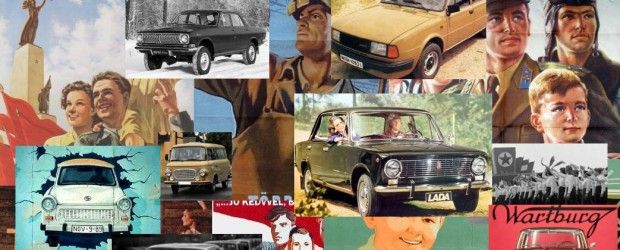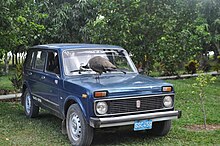The Lada Niva or VAZ-2121 (Russian: Лада Нива; Niva (нива) is the Russian word for "crop field") is an off-road vehicle produced by the Russian (former Soviet) manufacturer Lada. It was also marketed as the Lada Sport in Iceland, Lada Taiga in Austria, Bognor Diva in Uruguay, and is currently offered as the Lada 4x4in Russia.
It was one of the first mass production off-road vehicles to feature a unibody architecture (the first was GAZ-M-72 in 1955), independent front suspension and coil suspension, and is a predecessor to current crossover SUVs which nearly all follow this format. A pickup and emergency van versions are produced by VAZInterService.

| Manufacturer | Lada |
|---|---|
| Also called | Lada 4x4 (Russia) Lada Sport (Iceland) Lada Taiga (Austria) VAZ 2121 (Russia) Bognor Diva (Uruguay) Lada Bushman (Australia) |
| Production | 1977–present |
| Assembly | Tolyatti, Russia Montevideo, Uruguay Bogota, Colombia Ust-Kamenogorsk, Kazakhstan Quito, Ecuador (AYMESA) |
| Class | Mini SUV Compact Pickup |
| Body style | 3-door and 5-door SUV 2-Door, 4-door Pickup and van |
| Layout | Front-engine, four-wheel-drive |
| Engine | 1.6 L I4 (petrol) 1.7 L I4 (petrol) |
| Transmission | 4-speed manual 5-speed manual |
| Wheelbase | 2,200 mm (86.6 in) (3-door) 2,700 mm (106.3 in) (5-door) |
| Length | 3,740 mm (147.2 in) (3-door) 4,240 mm (166.9 in) (5-door) |
| Width | 1,680 mm (66.1 in) |
| Height | 1,640 mm (64.6 in) |
| Related | Chevrolet Niva |
Lada Niva test in Hungarian
History
The Niva (2121) was described by its designers as a “Renault 5 put on a Land Rover chassis.” It was Ladas (VAZ/AvtoVAZ) first non-Fiat based model. Much of its mechanicals are carried over from the Fiat based Lada models, though the body, four-wheel drive system, and front suspension were designed by Lada. Production began in 1977.
In basic form, the Niva has a carbureted 1.6-litre overhead cam four-cylinder petrol engine producing 54 kW (72 hp) and 126 N·m (93 lb·ft), a four- or five-speed manual transmission, and full-time four-wheel drive. The four-wheel drive system employs three differentials (centre, front and rear), similar to manual-transmission Toyota FJ Cruisers. There are no locking hubs. The transfer case involves a high/low range selector lever and a central differential lock lever. Low range can be selected with the centre differential locked or unlocked. The original Niva has a maximum speed of around 130 km/h (80 mph), and can cruise at 90 km/h (56 mph) while consuming petrol at 8.25 L/100 km (34.2 mpg-imp; 28.5 mpg-US). Its towing capacity is rated for up to 860 kg (1900 lb).
A 1.7-litre petrol engine was introduced later in production, as was single-point fuel injection supplied initially by General Motors. Around this time the rear hatch was revised to have a lower opening. Multi-point fuel injection designed by Bosch is used currently since 2004. In some markets a 1.9L Peugeot XUD diesel powered Niva was sold.
Coil springs are located at each of the four wheels, and suspension is independent in front, whereas the rear axle is a 5 link live-type, with ratios between 3.90 and 4.30 depending on the model and market. Ground clearance is good at 235 mm (9.25 in) and water 510 mm (20 in) deep can be negotiated.
The brakes (disc front, drum rear) are servo-assisted dual-circuit style and the clutch is hydraulic. The turning circle, at 36.25 is adequate, while the centre of gravity is exceptional. Cargo space is 0.48 m³ (17 ft³), or 1.33 m³ (47 ft³) with the rear seats folded down. A spare tyre is located in the engine bay under the bonnet, and as with all Ladas, a 21 piece toolkit is also supplied for do-it-yourself roadside repairs. The latter feature is considered a useful and practical feature by off-road fans.
Cossack
During the 1980s local Lada importers in various markets made their own upgrades to help compete with more modern SUVs. In the UK the Cossack model featured large body decals, roof rails, running boards, 15" alloy wheels, and on some versions a sunroof, steel bullbars, spotlights, a rear-mounted spare tyre and semi-bucket seats. Other markets importers made similar upgrades and many were also called Cossack.
In 1995, Lada UK introduced a face-lifted version of the Niva Cossack and renamed the basic model as the Hussar. Whereas the Hussar had the original 1977 trim, the new UK Cossack featured a new Rover-designed grille and other body kit items, and gained soft nudge-bars at the front in deference to public opinion against bullbars. Both models received the same new 1.7-litre engine and a new deeper tailgate which extended the rear opening to the level of the bumper - a vast improvement over the original models high lip. Official Niva imports to the UK ceased in 1997 due to the importers having difficulty in sourcing the GM fuel injection unit required to satisfy ever-tightening UK emissions regulations.
There were several attempts to reintroduce Ladas back into the UK. In May 2010, the basic Niva became available again, through an independent importer. Aimed largely at the agricultural market, three models were made available (all LHD), the 3-door 4-seat hatchback at £10,000, a 2-seat commercial van, £8000 and a 2-door, 4-seat pickup for £12,000. All meet the current UK Vehicle Certification Agency standards. The only engine available is the 1.7 litre petrol, but this can be provided with or without a LPG conversion.
VAZ-2122 Reka
In 1974, when VAZ 2121 development was almost finished, the engineers from Tolyatti began working on an amphibian off-roader, VAZ 2122 Reka (River) based on VAZ-2121 Niva underpinnings. It was intended to be sold to the Soviet Ministry of Defence. Six evolutions of prototypes were built, and much development work was done. The car was tested in an experimental military unit, on the proving grounds of the Ministry of Defence, and in the Turkmenistan Karakum Desert. VAZ-2122 received very positive feedback, by 1987 VAZ had finished all development work, and the car was ready for production.
However, at the end of the 1980s, the Ministry of Defence did not have the financial resources necessary for large-scale purchases of the VAZ-2122. As a result, it was never put into mass production.
LWB Nivas
Long-wheelbase versions - the five-door VAZ-2131 and three-door VAZ-2129 - were also produced from 1994, but not generally exported.
Uses of the Niva
In Russia and Europe the Niva has been used as an ambulance, a military vehicle, and by various police forces (e.g. Czech Republic) and utility companies (e.g. Manx Electricity Board). It also saw service for a time as a vehicle for lifeguards on beaches in the Netherlands.
Transmanche-Link, the commercial consortium that built the Channel Tunnel between England and France, used a fleet of 45 Nivas to aid in the enormous project. Each Niva accumulated in excess of 70,000 kilometres (43,000 mi) off-road during its employment, and after construction had been completed in 1993, the fleet was sold off to a local dealer.
In Brazil, the Niva was the best-selling off-road vehicle during the early 1990s. In fact, the Niva was so cheap that even with the 85% importation value tax, it was less expensive than Brazilian competiors such as the Envemo or Gurgel. It sold so much more than the Gurgel Carajás, that Gurgel discontinued production in January 1991. The Niva was the first imported 4X4 in the Brazilian market, following then-Brazilian president Fernando Collors decision to permit the importation of foreign vehicles in 1990. In the Brazilian market, a used 1991 Niva in good condition costs about R$6,000. Competition and higher importation value taxes forced the Niva to be retired from the Brazilian market. Even so, thousands of Nivas remain in use in Brazil.
Nivas have been driven on land, up mountains, through mud, and underwater.
As of early January 2013, a Niva became the symbol of the oppositions Resistance movement in Republic of Macedonia. Nivas can be seen in almost all public gatherings organized by the movement.




